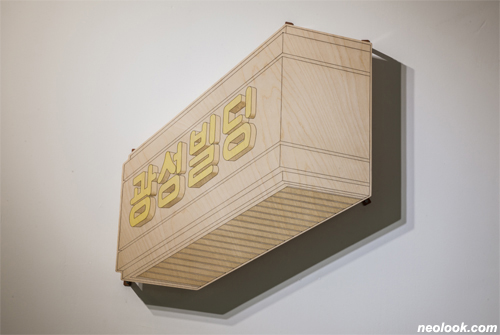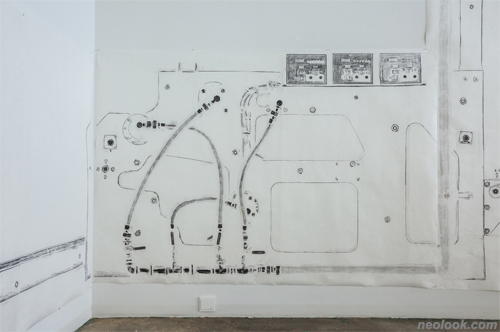- ● homepage
- ● archives
- ● restoration
- ● books
- ● big banners
- ● post board
- ■ neo's search
- ■ about us
- ■ 게재방법 안내
- 개인정보처리방침

- [email protected]
- Tel. 02_335_7922
- Fax. 02_335_7929
- 10:00am~04:30pm
- 월요일~금요일
- 3/3(월) 대체공휴일

성수동 일요일
정희우展 / JEONGHEEWOO / 鄭希宇 / painting 2018_0705 ▶ 2018_0831 / 일,공휴일,8월 2~5일 휴관
● 위 이미지를 클릭하면 네오룩 아카이브 Vol.20160810d | 정희우展으로 갑니다.
별도의 초대일시가 없습니다.
후원 / 서울특별시_서울문화재단_문화체육관광부
관람시간 / 10:00am~06:30pm / 일,공휴일,8월 2~5일 휴관
레이블갤러리 LABEL GALLERY 서울 성동구 성수이로26길 31 (성수동2가 278-40번지) labelgallery.co.kr
불특정한 다수의 사람들이 모여 다니면서 서로를 훔쳐보는 동시에 다양한 볼거리를 완상하는 공간인 광장은 르네상스기에 태동 되었다. 이탈리아의 베네치아 광장이 바로 그 대표적인 곳이다. 그로 인해 현란하고 웅장한 건축물, 그곳을 채운 무수한 시각 이미지들, 조각, 그리고 패션 등이 등장하면서 이른바 보는 문화가 정착되었다. 미술과 건축, 패션은 그야말로 광장의 소산인 셈이다. 그런 측면에서 서구 근대는 공공의 장소, 도시문화의 발전과 궤를 같이 한다. 중세를 탈피해 근대로 향해가던 콰토르첸토시대(15세기)를 거쳐 산업혁명 이후 대다수 사람들의 보편적인 삶의 공간은 이제 자연에서 도시로 이동했다. 오늘날 우리들의 삶은 철저하게 도시 공간 안에서 규정된다. 발터 벤야민은 이에 대한 예언적 인식을 아케이드프로젝트에서 적나라하게 드러내고 있다. 현재 도시 공간은 무수한 볼거리로 가득 채워져 있다. 도시는 그런 의미에서 거대한 시각 이미지의 보고이다. 그곳에서 생을 영위하는 모든 이들은 도시를 에워싸고 있는 사물, 상품, 이미지 등이 발산하는 여러 기호를 통해 소통하고 욕망하며 다양한 감각을 받아들이고 있다. 그러니 도시에서 산다는 것은 그곳의 이미지를 어떻게 독해하느냐의 문제와 분리될 수 없다. 정희우의 작업은 바로 그런 맥락에서 출현한다.

- 정희우_성수동일요일_성신정밀_수묵채색_220×211cm_2018

- 정희우_성수동일요일_으뜸_합판커팅_37×76cm_2018

- 정희우_성수동일요일_광성빌딩_합판커팅_64×69cm_2018
작가는 어느 일요일, 산책자 구보씨처럼 성수동 일대를 배회했다. 보들레르 식으로 말하면 이른바 플라뇌르(고독한 산책자)가 된 것이다. 지금은 많이 쇠락했지만 한때 번성했던 공장지대를 유추하게 해주는 허름한 건물들과 낡은 간판들, 닫힌 셔터, 그리고 새롭게 들어선 가게들이 혼재하는 공간을 관찰했다. 이때 작가의 눈에 들어온 것은 보기 드문 나무 간판들이었다. 단단한 나무판에 부조로 깎아 문자를 새긴 간판은 오늘날 찾아보기 힘든 추억의 오브제다. 이는 지난 시절 번성했던 성수동의 한때를 불현듯 상기시켜주는 역사적 매개이자 그것 자체로 흥미로운 시각 이미지, 라벨적인 효과를 지닌 기표이기도 하다. 작가는 그 간판들에 기생해 나가면서 탁본을 하고 여기에 채색을 입혔다. 탁본이란 이미 존재하는 사물의 피부에 쓰라리게 붙어 나가면서 복제해내는 가장 기본적인 이미지 재생수단이자 동시에 오로지 피부로만 존재할 수밖에 없는 회화의 운명을 드러내 보여주는 평면작업이다.

- 정희우_성수동일요일_으뜸_합판커팅_76×37cm

- 정희우_성수동일요일_현대대중탕_펠트커팅_157×12cm_2018
이처럼 작가는 성수동 일대를 다니다 매력적인(?) 간판을 찾아 탁본을 하거나 혹은 점포를 정해서 실물 크기에 가깝게 정면을 그리기도 했다. 간판과 건물 입면을 비스듬한 시점에서 본 것을 그려서 컷 아웃으로 패널을 만들기도 했으며 ㈜세림 공장의 기계와 제품을 건탁기법으로 탁본하기도 했다. 그것들이 실제 전시장에 부착되는 순간 묘한 착시감이 발생한다. 우리는 마치 성수동 일대를 거닐고 있다는, 특정 공장에 들어와 있다는 묘한 환시에 시달린다. 이 작업은 결국 이미 존재하는 도시를 구성하는 이미지들, 레디메이드라고 부를 수 있는 다양한 이미지를 발견하고 여기에서 묘한 미감과 시간에 대한 향수와 지난 역사와 사람들의 체취와 흔적을 읽어내고자 하는 다분히 고고학적인 관심(이른바 고현학적 관심)을 반영한다. 도시는 이처럼 무수한 기호, 라벨로 치장되어 있고 그것들 역시 매우 중요한 시각 이미지이자 미술에 다름 아니다. 우리는 미술을 오로지 전시장 안에 갇혀 있는 매우 제한적인 것으로만 보거나 읽는다. 이해하려 한다. 그러나 정희우의 시선과 동선에 의해 포착된 간판들에 의해, 그 흥미로운 기호(라벨)들에 의해 우리는 시각 이미지, 미술이 얼마나 풍요하고 흥미롭게 넓혀질 수 있는가를 알게 된다. 간판들과 기계들 역시 우리에게 생각거리를 안겨주는 시각 이미지이다. 아울러 그것들이 공간을 차지하면서 인간의 삶과 문화와 역사를 만들어내는 데에 중요한 역할을 해왔던 기호들, 라벨들이었음을 새삼 깨닫게 해주는 것이다. ■ 박영택

- 정희우_성수동일요일_탁본에 채색_각 150×30cm 내외_2018

- 정희우_성수동일요일_합지기계_탁본_230×898cm_2018

- 정희우_성수동일요일_합지기계_탁본_230×898cm_2018_부분
Sunday in Seongsu-dong The plaza, a space where unspecified individuals throng, steal glances at one another, and witness diverse spectacles, came into being during the Renaissance period. Piazza Venezia is a typical example. As showy, magnificent buildings, innumerable visual images, sculptures and fashion filled such places, a so-called "seeing culture" came to be established. Art, architecture, and fashion are indeed the products of plazas. In this sense, Western modern times is in line with the evolvement of public space or urban culture. Life spaces for the majority of people moved from natural spaces to cities as they went through the Quattrocento (15th century) and the Industrial Revolution after the Middle Ages. Today our lives are thoroughly defined within urban spaces. Walter Benjamin clarified his prophetic perception toward this in his Arcades Project. Urban spaces are currently full of a wide array of spectacles. In this sense, a city is a rich enormous repository of visual images. Everyone who lives there can communicate with one another through symbols deriving from things, commodities, and images in the city, desiring and accepting them with diverse perceptions. All the same, living in a city cannot be in disagreement with the matter of how to interpret images there. Jeong Hee-woo's work concern such a context. ● One Sunday Jeong roamed around the streets of Seongsu-dong, Seoul like novelist Gubo did in a novel. To speak in the way of Charles Baudelaire, she is a flaneur (the urban explorer). She observed an area with newly opened stores mixed with shabby buildings, worn out signs, and closed shutters redolent of an industrial area that was once prosperous but currently remains declined. At that moment, wooden signs seldom found nowadays came into her line of vision. They are historical medium that serve as a reminder of a time when Seongsu-dong was flourishing. They are also interesting visual images and signifiers that have an effect similar to labels. ● The artist made rubbings of the wooden signs and applied colors to them. A rubbing is the most elemental means by which one can reproduce images. It is done by attaching a piece of paper to the surface of something. It also functions as a two-dimensional work that unmasks the destiny of painting that exists as only skin. As such, the artist made rubbings of appealing (?) signs she found around Seongsu-dong and depicted the façade of a shop at almost to its actual size. She also drew signs and buildings at an oblique optical angle and made dried rubbings of machines and products from Saelim factory. A strange optical illusion arises the moment they are put on the walls of a venue. We become plagued by visual hallucination we are waking around Seongsu-dong or in a certain kind of factory. ● This work reflects archeological interest (so-called modernological interest) in that it discovers readymade images molding an already existing city and imparts a feeling of a strange aesthetic sense and nostalgia for time and past traces of history and people. In this way, a city is embellished with innumerable symbols and labels that are also very important visual images and part of the fine arts. We tend to consider art trapped in or limited by an exhibit space. ● That being said, we come to realize how visual images or art can be enriched and broadened by the signs or such intriguing symbols (labels) that Jeong captures. Both signs and machines are visual images that lead viewers to think about things. In addition, they make us realize such symbols and labels assume a significant role in forging human life, culture and history. ■ Park Young-taik
Vol.20180705c | 정희우展 / JEONGHEEWOO / 鄭希宇 / painting

